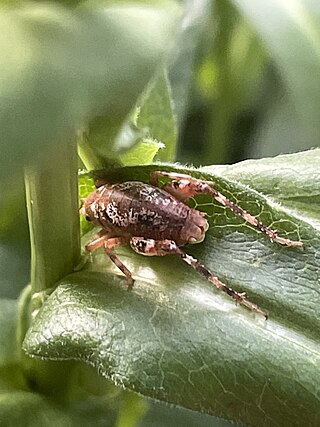
Convolvulaceae, commonly called the bindweeds or morning glories, is a family of about 60 genera and more than 1,650 species. These species are primarily herbaceous vines, but also include trees, shrubs and herbs. The tubers of several species are edible, the best known of which is the sweet potato.

Pachomius is a genus of jumping spiders that was first described by George and Elizabeth Peckham in 1896. Uspachia was merged into genus Romitia in 2007, and all nine species were merged into Pachomius in 2015. The name is derived from Pachomius, the founder of cenobitic monasticism.
Tauala is a genus of jumping spiders that was first described by F. R. Wanless in 1988. The name "Tauala" is an arbitrary combination of letters.

Lepidurus is a genus of small crustaceans in the order Notostraca. It is the larger of the two extant genera of the tadpole shrimps, the other being Triops. They are commonly found in vernal pools and survive dry periods with the help of long lasting resting eggs.

Acimetopus Rasetti, 1966, is a genus of Eodiscinid trilobite belonging to the family Weymouthiidae Kobayashi (1943), Order Agnostida Salter (1864). It lived during the Botomian stage. = late Lower Cambrian Stage 4 ; the upper Botomian boundary corresponds to base of the Middle Cambrian, Miaolingian Series and Wuliuan stage.

Analox Rasetti, 1966 is a genus of Eodiscinid trilobites belonging to the family Weymouthiidae Kobayashi T. (1943), Order Agnostida It lived during the Botomian stage. It can easily be distinguished from other trilobites by the two furrows that extend forwards and sidewards from the front of the glabella.
Ethiosciapus is a genus of flies in the family Dolichopodidae.
Spirembolus is a genus of North American sheet weavers that was first described by Ralph Vary Chamberlin in 1920.

Saururus is a genus of plants in the family Saururaceae containing two species. Saururus cernuus is native to North America, and Saururus chinensis is native to Asia.
Aconodes bilobatus is a species of beetle in the family Cerambycidae. It was described by Stephan von Breuning in 1939. It is known from India.
Eremochelis oregonensis is a species of windscorpion in the family Eremobatidae.
Aleodorus bilobatus is a species of rove beetle in the family Staphylinidae. It is found in North America.

Brachycentrus is a genus of humpless casemaker caddisflies in the family Brachycentridae. There are at least 30 described species in Brachycentrus.

Gammarotettix is a North American genus of camel crickets in the family Rhaphidophoridae. They are also called chaparral camel crickets or arboreal camel crickets and are between 10-18 mm. They live mainly in California and possibly in southern Oregon and Arizona.
Gammarotettix bilobatus, also known as the arboreal camel cricket, is a North American species of camel cricket in the family Rhaphidophoridae. It is found in California, including along the Coast Ranges and as far south as Gilroy. Adults emerge in February and live until June. Host plants of G. bilobatus include California buckeye, California bay, coast live oak, barberry, Monterey pine, black locust, California lilac, and Christmas berry. To evade predators such as the chestnut-backed chickadee, they jump to the ground.

Panurginus is a genus of bees in the family Andrenidae. There are more than 50 described species in Panurginus.

Hemiandrus bilobatus, the wine wētā, is a species of ground weta endemic to New Zealand. Being a ground weta, they are often found in burrows in the ground during the daytime. The species is found in Wellington, on Mana Island and northern South Island and is classified as "Not Threatened". This species of weta is unusual for an insect in that the female shows maternal care. She lays about 50 eggs in the same burrow she uses during the day and looks after her eggs until they hatch.

Briggsus is a genus of armoured harvestmen in the family Cladonychiidae. There are about five described species in Briggsus, found in the coastal forests of Oregon and Washington.

Triangulus is a genus of parasitic barnacles in the family Triangulidae, the sole genus of the family. There are at least four described species in Triangulus.

Mesoamericus bilobatus, also known commonly as O'Shaughnessy's galliwasp, is a species of lizard in the family Diploglossidae. The species is native to Central America.












